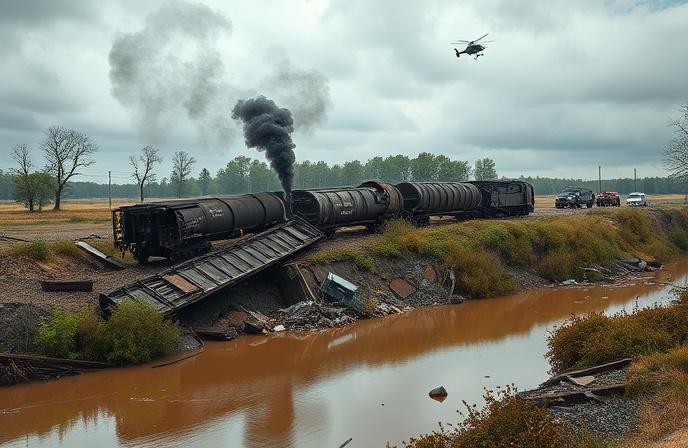CRISI Program: Funding US Rail Infrastructure

The United States faces significant challenges in maintaining and upgrading its vast railway network. This article explores the crucial role of federal funding in addressing these challenges, focusing specifically on the Consolidated Rail Infrastructure and Safety Improvements (CRISI) Program. The CRISI program, administered by the Federal Railroad Administration (FRA) within the Department of Transportation (DOT), provides vital financial support for a wide range of rail projects aimed at improving safety, efficiency, and overall reliability. This analysis delves into the specifics of a recent CRISI funding opportunity, examining the types of projects eligible for funding, the criteria used for selecting recipients, and the overall impact of this initiative on the nation’s freight and passenger rail systems. Understanding the intricacies of this program and its implications for the future of rail transportation in the US is critical for stakeholders across the industry, from private railway companies to state and local governments.
The CRISI Program and its Funding Mechanisms
The Consolidated Rail Infrastructure and Safety Improvements (CRISI) Program is a cornerstone of the US government’s efforts to modernize and enhance the nation’s railway infrastructure. The program’s funding is derived from various sources, including congressional appropriations, and is allocated through a competitive Notice of Funding Opportunity (NOFO) process. This process ensures a transparent and merit-based selection of projects, prioritizing those that demonstrably contribute to the improvement of safety, efficiency, and reliability. The NOFO process typically involves a detailed application procedure, requiring applicants to submit comprehensive project proposals that address specific criteria outlined by the FRA. These criteria may include project feasibility, cost-effectiveness, environmental impact, and potential for leveraging additional funding sources.
Prioritization of Projects and Eligibility Criteria
The FRA employs a multifaceted approach in evaluating project proposals submitted under the CRISI program. While the NOFO outlines specific eligibility criteria, the selection process prioritizes projects based on several key factors. These factors often include the extent to which the project addresses critical safety concerns, such as the elimination of highway-rail grade crossings or the implementation of advanced safety technologies. Furthermore, projects demonstrating a strong potential for enhancing efficiency and reliability, such as infrastructure upgrades and capacity expansions, receive preferential consideration. A significant portion of available funding is specifically allocated for projects located in rural communities, recognizing the unique infrastructural challenges faced by these areas. The FRA also seeks geographic diversity in its funding distribution, ensuring that projects across various regions of the country benefit from the program.
Impact on Freight and Passenger Rail Systems
The CRISI program’s impact extends significantly across both freight and passenger rail systems. For freight rail, CRISI funding facilitates vital improvements to track infrastructure, enhancing the capacity and efficiency of freight transportation. Upgrades to rail lines and supporting infrastructure contribute to the reliable and timely movement of goods, vital for maintaining the nation’s supply chains. Similarly, funding directed towards intercity passenger rail capital assets improves the quality and reliability of passenger services. This investment improves the passenger experience and promotes rail as a competitive mode of transportation. The overall effect of these improvements is increased safety, enhanced efficiency, and greater reliability across the entire rail network.
Funding Allocation and Future Outlook
A specific example of CRISI’s impact is a recent $311.8 million funding opportunity. This allocation demonstrates the program’s significant financial commitment to rail infrastructure improvements. The funds are distributed strategically, with a portion reserved for rural communities and a focus on projects with a lower federal share of total costs (less than 50%). Projects addressing specific needs, like acquiring rights-of-way, tracks, and track structures (under 49 U.S.C. 22907(c)(2)), also receive dedicated funding. The future outlook for CRISI remains positive, reflecting the ongoing need for investment in rail infrastructure. The program’s continued success hinges on several factors, including sustained federal funding, a streamlined NOFO application process, and effective project management by recipients. As long as the need for efficient and reliable rail transportation persists, the CRISI program will remain a critical element in shaping the future of America’s railway network.
Conclusions
This analysis has highlighted the vital role of the Consolidated Rail Infrastructure and Safety Improvements (CRISI) program in bolstering the nation’s railway infrastructure. Administered by the Federal Railroad Administration (FRA), the program leverages federal funding to support a wide array of projects aimed at improving safety, efficiency, and reliability across both freight and passenger rail systems. The competitive NOFO (Notice of Funding Opportunity) process ensures a transparent and merit-based allocation of resources, prioritizing projects that demonstrate the greatest potential impact. Key criteria for project selection include addressing critical safety concerns, enhancing efficiency, and promoting geographic diversity, with a particular focus on supporting rural communities. A recent $311.8 million funding opportunity showcased the program’s substantial commitment to modernizing and improving the nation’s rail network. This funding enables improvements to track infrastructure, the elimination of highway-rail grade crossings, and upgrades to intercity passenger rail assets. The long-term success of the CRISI program depends on continued federal support, efficient administration, and effective project execution. As the US continues to rely on its railways for freight and passenger transportation, the CRISI program will remain a critical instrument in ensuring the safety, efficiency, and overall reliability of this vital transportation sector. The program’s focus on a holistic approach, encompassing both safety improvements and infrastructure upgrades, positions it to make a lasting contribution to the future of American rail transportation. Continued investment in programs like CRISI is crucial not only for economic growth but also for the sustainability and competitiveness of the nation’s transportation system.




